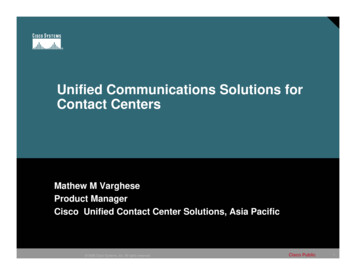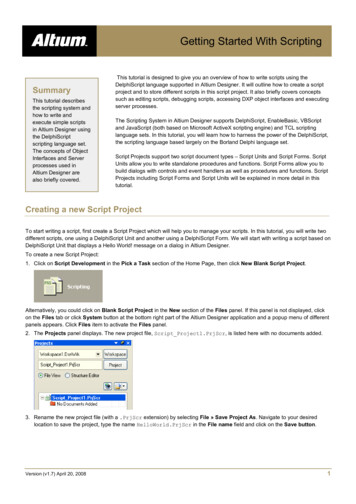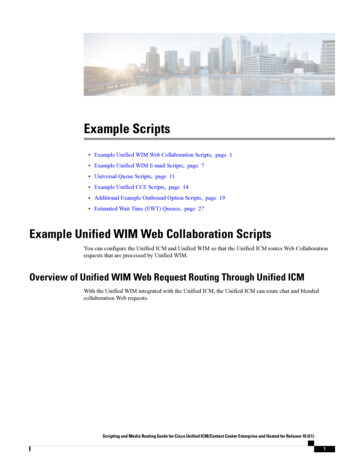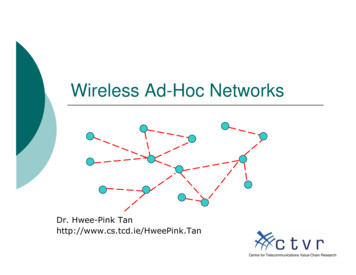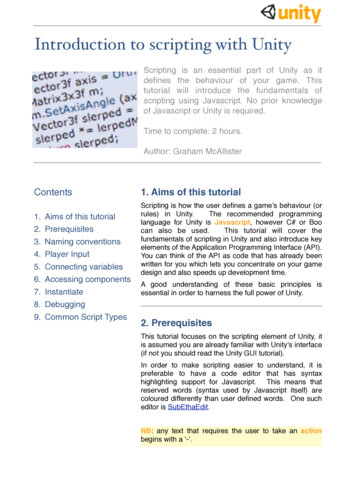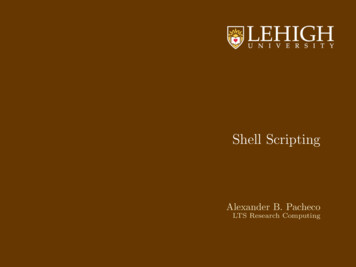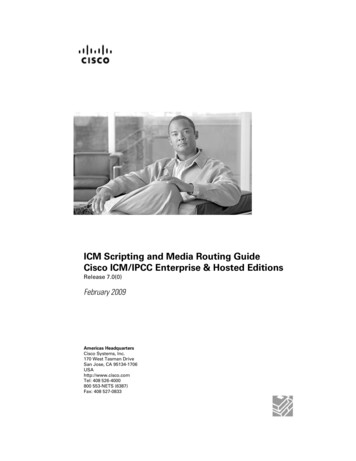
Transcription
ICM Scripting and Media Routing GuideCisco ICM/IPCC Enterprise & Hosted EditionsRelease 7.0(0)February 2009Americas HeadquartersCisco Systems, Inc.170 West Tasman DriveSan Jose, CA 95134-1706USAhttp://www.cisco.comTel: 408 526-4000800 553-NETS (6387)Fax: 408 527-0833
THE SPECIFICATIONS AND INFORMATION REGARDING THE PRODUCTS IN THIS MANUAL ARE SUBJECT TO CHANGE WITHOUT NOTICE.ALL STATEMENTS, INFORMATION, AND RECOMMENDATIONS IN THIS MANUAL ARE BELIEVED TO BE ACCURATE BUT ARE PRESENTEDWITHOUT WARRANTY OF ANY KIND, EXPRESS OR IMPLIED. USERS MUST TAKE FULL RESPONSIBILITY FOR THEIR APPLICATION OFANY PRODUCTS.THE SOFTWARE LICENSE AND LIMITED WARRANTY FOR THE ACCOMPANYING PRODUCT ARE SET FORTH IN THE INFORMATION PACKETTHAT SHIPPED WITH THE PRODUCT AND ARE INCORPORATED HEREIN BY THIS REFERENCE. IF YOU ARE UNABLE TO LOCATE THESOFTWARE LICENSE OR LIMITED WARRANTY, CONTACT YOUR CISCO REPRESENTATIVE FOR A COPY.The Cisco implementation of TCP header compression is an adaptation of a program developed by the University of California, Berkeley (UCB) aspart of UCB public domain version of the UNIX operating system. All rights reserved. Copyright 1981, Regents of the University of California.NOTWITHSTANDING ANY OTHER WARRANTY HEREIN, ALL DOCUMENT FILES AND SOFTWARE OF THESE SUPPLIERS ARE PROVIDEDWITH ALL FAULTS. CISCO AND THE ABOVE-NAMED SUPPLIERS DISCLAIM ALL WARRANTIES, EXPRESSED OR IMPLIED, INCLUDING,WITHOUT LIMITATION, THOSE OF MERCHANTABILITY, FITNESS FOR A PARTICULAR PURPOSE AND NONINFRINGEMENT OR ARISINGFROM A COURSE OF DEALING, USAGE, OR TRADE PRACTICE.IN NO EVENT SHALL CISCO OR ITS SUPPLIERS BE LIABLE FOR ANY INDIRECT, SPECIAL, CONSEQUENTIAL, OR INCIDENTAL DAMAGES,INCLUDING, WITHOUT LIMITATION, LOST PROFITS OR LOSS OR DAMAGE TO DATA ARISING OUT OF THE USE OR INABILITY TO USETHIS MANUAL, EVEN IF CISCO OR ITS SUPPLIERS HAVE BEEN ADVISED OF THE POSSIBILITY OF SUCH DAMAGES.CCSP, CCVP, the Cisco Square Bridge logo, Follow Me Browsing, and StackWise are trademarks of Cisco Systems, Inc.; Changing the Way WeWork, Live, Play, and Learn, and iQuick Study are service marks of Cisco Systems, Inc.; and Access Registrar, Aironet, BPX, Catalyst, CCDA, CCDP,CCIE, CCIP, CCNA, CCNP, Cisco, the Cisco Certified Internetwork Expert logo, Cisco IOS, Cisco Press, Cisco Systems, Cisco Systems Capital, theCisco Systems logo, Cisco Unity, Enterprise/Solver, EtherChannel, EtherFast, EtherSwitch, Fast Step, FormShare, GigaDrive, GigaStack, HomeLink,Internet Quotient, IOS, IP/TV, iQ Expertise, the iQ logo, iQ Net Readiness Scorecard, LightStream, Linksys, MeetingPlace, MGX, the Networkerslogo, Networking Academy, Network Registrar, Packet, PIX, Post-Routing, Pre-Routing, ProConnect, RateMUX, ScriptShare, SlideCast, SMARTnet,The Fastest Way to Increase Your Internet Quotient, and TransPath are registered trademarks of Cisco Systems, Inc. and/or its affiliates in the UnitedStates and certain other countries.All other trademarks mentioned in this document or Website are the property of their respective owners. The use of the word partner does not implya partnership relationship between Cisco and any other company. (0903R)Copyright 2009 Cisco Systems Inc. All rights reserved.
Table of ContentsPreface .1Purpose .1Audience .1Organization .1Related Documentation .2Obtaining Documentation.2Cisco.com.2Product Documentation DVD.3Ordering Documentation.3Documentation Feedback.4Cisco Product Security Overview.4Reporting Security Problems in Cisco Products .4Obtaining Technical Assistance.5Cisco Technical Support & Documentation Website.5Submitting a Service Request.6Definitions of Service Request Severity.6Obtaining Additional Publications and Information.71. Common Tasks.9How to Use Toolbars.10Viewing Toolbars.10The Palette.10Using the Palette to Build a Script.11General Tab.11Routing Tab.12Targets Tab.13Queue Tab.14How to Create a Routing Script .14How to Add Comments to a Node.15How to Specify Connection Label Location for a Node.16How to Validate Scripts.17How to Open Script Explorer.18How to Schedule a Routing Script.18Viewing Modes.20Using the Find Nodes Option.21Find Nodes and Nodes Found Dialog Boxes.22Common Find Nodes Dialog Box Properties.22Find Nodes By section.22Find Nodes In section.23Common Nodes Found Dialog Box Properties.23How to find nodes by Node ID.23How to find nodes by Object.24How to find nodes by Node Type.24How to find nodes by String.252. Call Types, Contact Data, and Scripting.27What is a Call Type? .27What is a Default Call Type? .28How Call Types and Scripts are Related.28ICM Scripting and Media Routing Guide Cisco ICM/IPCC Enterprise & Hosted Editions Release 7.0(0)i
Call Type Qualifiers.28Dialed Number (DN).29Calling Line ID (CLID).29Using a CLID Prefix.29Using a CLID Region .29Caller-entered Digits (CED) .30Data for Web Requests.30Data for E-Mail Requests .31How ICM Software Associates Contacts with Call Types.31Example - How ICM Software Determines the Call Type for a Voice Contact .32Example - How ICM Software Determines the Call Type for a Web Request .33Example - How ICM Software Determines the Call Type for an E-Mail Contact .333. Categorizing Contacts.35Categorization and Call Types.35Categorization through Scheduling Scripts by Call Type.35How to Change the Call Type and Continue Script Processing.35How to Change the Call Type and Execute a New Script.36Categorizing by Call Type Qualifiers.37How to Categorize a Contact by the Dialed Number.38How to Categorize a Contact by the Calling Line ID.39How to Categorize the Contact by the Caller Entered Digits (CED) .41Categorizing by Time and Date .43How to Categorize a Contact by the Time .43How to Categorize a Contact by the Day of Week .45Categorizing by Branching .46How to Execute a Different Script .47How to Direct Script Execution to a Specific Branch.48How to Direct Script Execution to Different Branches by Percentage.49How to Categorize a Contact based on a Condition.50How to Categorize a Contact Based on its Media Routing Domain .51Categorizing By External Data .51How to Modify the CallRouter Registry to Provide for DB Lookup Authentication on the Remote DatabaseTarget.52How to Categorize a Contact by External Data.52How to Reference Retrieved External Data.53Categorizing by External Applications .544. Selecting Routing Targets.57What is a Routing Target?.58What is a Route?.58What is a Translation Route?.58What is a Target Set? .58Skill Target.58Agents: How to Define a Set of Agents Who Can Receive the Contact.59Agent Node.59Skill Groups: How to Define a Set of Skill Groups That Can Receive the Contact.60Services: How to Define a Set of Services That Can Receive the Contact.62Enterprise Skill Groups: How to Define a Set of Enterprise Skill Groups That Can Receive the Contact.63Enterprise Services: How to Define a Set of Enterprise Services That Can Receive the Contact .65Network Targets.66How to Route a Call to an Announcement.66ICM Scripting and Media Routing Guide Cisco ICM/IPCC Enterprise & Hosted Editions Release 7.0(0)ii
How to Route a Call to a Scheduled Target .68How to Route a Call to an Unanswered Ring.69How to Route a Call to a Busy Signal .69How to Return a Label to a Routing Client.70How to Return Multiple Labels to a Routing Client.71Selecting Targets by Rules .73Types of Target Searching.73Standard Selection Rules.73Custom Selection Rules.75How to Select Targets by Rules.76Distributing Contacts to Targets .78Selecting Targets and Distributing Contacts Using One Node.79Transferring Calls from Agents to Agents.82Sending a Contact to a Different ICM System.84Stopping Script Processing.85End Node.86Termination Node.86Release Call Node.87Using Target Requery .87How Target Requery Works.88How to Test the RequeryStatus Variable.88Which Nodes Support Target Requery.89Target Requery with IPCC and IP IVR.89Using Target Requery .90Checking Targets .90About Call Tracer.90How to Check Targets .90Example Results.91How to Check VRU Scripts.935. Network VRUs.95What is a VRU.95What is a Network VRU?.96Configuring VRUs.96Network VRU Types and Script Nodes.96Accessing VRU Scripts in ICM Scripts.97Sending a Call to a VRU with the Send to VRU Node .97Sending a Call to a VRU with the Translation Route to VRU Node .98Sending a Call to a VRU after a Translation Route to VRU.101Running External Scripts.102Checking for VRU Errors .104Queuing Calls at VRUs .105Placing a Call in Queue .105Adjusting the Priority of a Call in a Queue .108Removing the Call from a Queue .109VRU MicroApp Nodes .110Collecting Data from the Caller.110Prompting a Caller to Select from a Set of Options .113Playing Specific Recordings to the Caller .116Overriding VRU Settings .119Temporarily Halting Script Execution.120ICM Scripting and Media Routing Guide Cisco ICM/IPCC Enterprise & Hosted Editions Release 7.0(0)iii
6. Multichannel Routing.123Overview of Multichannel Services.123Supported Route Requests.123Routing Application Requests.123Synchronized Agents and Skill Groups.124Independent Media Queues.124Universal Queue.125What is Universal Queue?.125Universal Queue IPCC Requirement.125Universal Queue Configuration Overview.125Multichannel Scripting and Media Routing Domains.125What is a Media Routing Domain?.125Media Routing Domains and Interruptibility.126How to Use Media Routing Domains to Categorize Contacts .126Queuing to Agents.127How to Change the Queue to Agent Type.128How to Specify an Agent Directly.128How to Select an Agent by an Expression.1297. Using Formulas.133What is a Formula?.133Formula Example.133Variables.134What is a Variable?.134Variable Syntax.134Single-Target Variables.134Multiple-Target Variables.135What are Call Control Variables?.135What are Expanded Call Context (ECC) Variables?.136Persistent vs Non-Persistent Call Variables.137Expanded Call Context Variables for E-Mail Manager Messages.137Expanded Call Context Variables for Web Callback.137What are User Variables?.138How to Set Variable Values with the Set Variable Node.139SkillGroup.Avail And SkillGroup.ICMAvailable Variables.140SkillGroup.ICMAvailable Variable.140SkillGroup.Avail Variable.140Operators.141Prefix Operators.141Arithmetic Operators.142Equality Operators.142Relational Operators.142Logical Operators.143Bitwise Operat
ICM Scripting and Media Routing Guide Cisco ICM/IPCC Enterprise & Hosted Editions Release 7.0(0) February 2009 Americas Headquarters . Cisco Systems logo , Cisco Unity, Enterprise/Solver, EtherChannel, EtherF ast, EtherSwitch, F ast Step, FormShare, GigaDrive, GigaStac k, HomeLink,
